23 Aug Learn the Secrets of the Great Wheel with Martha Owen
[vc_row css_animation="" row_type="row" use_row_as_full_screen_section="no" type="full_width"...

[vc_row css_animation="" row_type="row" use_row_as_full_screen_section="no" type="full_width"...
[vc_row css_animation="" row_type="row" use_row_as_full_screen_section="no" type="full_width"...
Join us every Friday morning...
The days have pushed themselves...
I stopped by the Yarn Circle on a Monday afternoon to speak with Martha Owen, our beloved longtime Resident Artist in Spinning, Knitting, Dyeing and Felt Making. We talked about many things including fiber arts, raising sheep, travel, artistic process, Fair Isle, her rich history with the Folk School, and more. Enjoy our interview!
[caption id="attachment_10134" align="aligncenter" width="480"]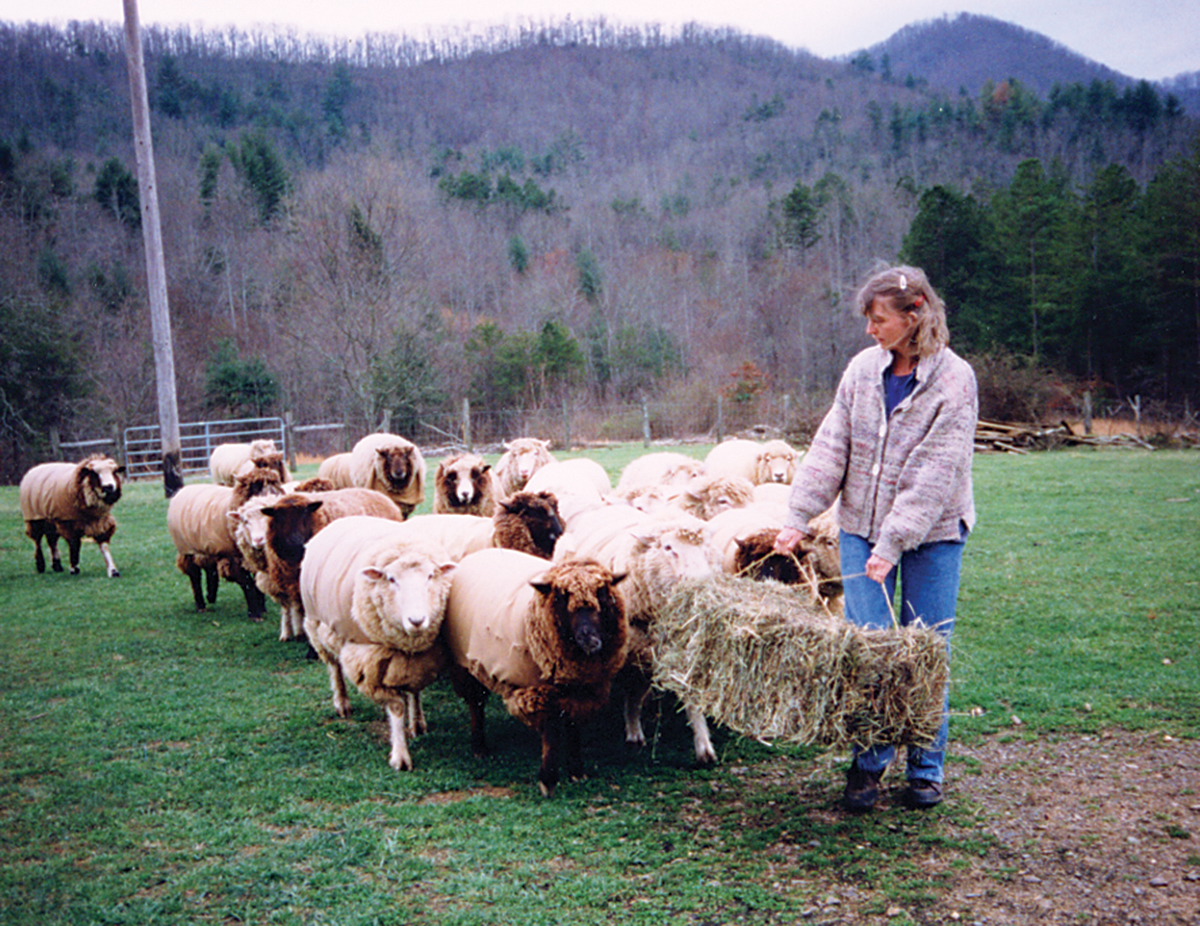 Don't ever lead your sheep with feed! A student photo op pic by Bonnie Shearer[/caption]
Don't ever lead your sheep with feed! A student photo op pic by Bonnie Shearer[/caption]
CP: How did you become involved with the Folk School?
MO: There was one year when I was a wee lass that I came to Little Folk School. I must have been 8, 9, or 10. I grew up in Pennsylvania, but my mother, Mary Porter Fain Owen came from Murphy. I would spend the summers here with my grandmother. At that time there was only one group of kids in Little Folk School. I learned to dance and I still sing the song I learned.
[caption id="attachment_10131" align="alignright" width="284"]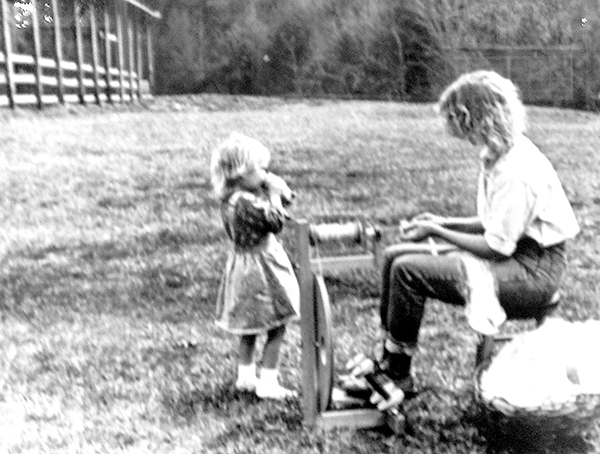 Photo shoot for Early American Life Magazine: Spinning near Festival Barn, August 1988 - That's Emolyn drinking a "grape coke" and trying to be good[/caption]
Photo shoot for Early American Life Magazine: Spinning near Festival Barn, August 1988 - That's Emolyn drinking a "grape coke" and trying to be good[/caption]
The next time, I was in college and I came for dancing again. I was doing volunteer work with a local church and we came to the dance one night. One summer my mother gave me a spinning wheel she had gotten from my great aunt and said: “Look! You always did like weird stuff.” She put the wheel down in front of me walked off and I thought “Well, I don’t know how to work with this thing.” My grandmother was reading the Cherokee Scout and saw an ad that the Campbell Folk School had a two-week class in Spinning and Dyeing. She said "Why don’t you go down and learn?" I said “Well, maybe I will.”
The full craft program that we have now had started in the '70s. The class was taught in Open House by Pam Strawn. We would card and spin and then do a dye pot when we had a pound of yarn between all of us. From that I made my first vest and I wore it for years to prove to my students that you should make something for any yarn you spin, you don’t have to wait until you spin “perfect” yarn.
My whole life turned left after taking that spinning class. That was 1978. I married my enabler, David Liden in 1979, and I had sheep by 1980.
CP: Tell me about your first sheep.
MO: I bought two ewes with lambs by their sides. One of the lambs was called "Maw Maw" and was the same age as my oldest daughter, Annie Fain. Maw Maw's portrait is hanging in our house. She was a pretty important sheep and I learned a lot of things from her. She lived to be 17.
CP: Do you have tips for beginning sheep owners?
[caption id="attachment_10141" align="alignleft" width="237"]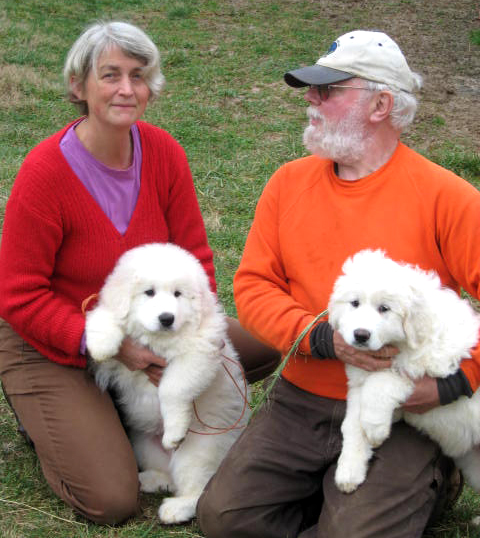 Ro-bear and Julliet, our current Great Pyrenees dogs - they weigh at least 125 pounds each now and live with the sheep (Oh, and Martha and David!) - Photo by Charlotte Crittenden[/caption]
Ro-bear and Julliet, our current Great Pyrenees dogs - they weigh at least 125 pounds each now and live with the sheep (Oh, and Martha and David!) - Photo by Charlotte Crittenden[/caption]
MO: Now I have 35 sheep, but you've got to start small. Sheep reproduce quickly. While you are learning about things like housing, worming, and hoof trimming, etc, the fewer sheep the better. Security is also top priority. Sheep don’t have a way to protect themselves besides snorting, stomping, and running away which is very attractive to dogs. The biggest problems you have are neighbors' dogs and strays. Try security animals like llamas, donkeys, or Great Pyrenees. I have two Great Pyrenees right now. I haven't had any predator problems since they have been here. We are on our fourth generation. A border collie's job is the tell the sheep what to do, but the Pyrenees protect the sheep. They live with the sheep.
CP: As a current resident artist, one of your duties is to schedule teachers for the knitting, dyeing, felt making and spinning classes at the Folk School. How do you find them?
MO: Every possible way you can think of. We need someone who is passionate about what they do, someone who has done their craft a lot, but is a good teacher. I am always looking around and listening.
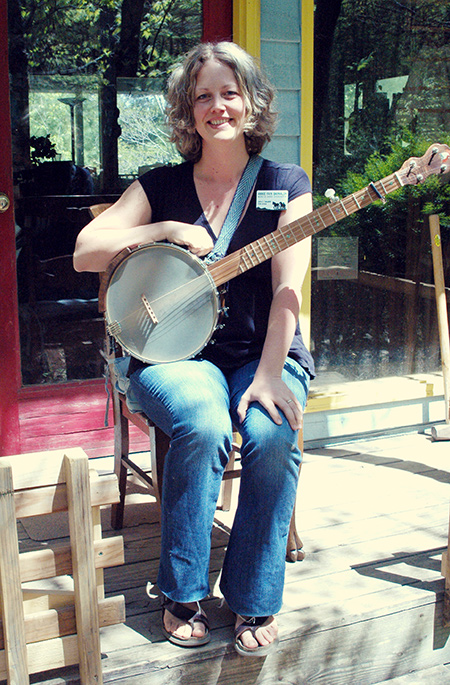 Annie Fain with her banjo[/caption]
Cory Marie: What’s is like returning to the Folk School Community as a full time resident and employee?
Annie Fain: It feels good in a deep down way. Many things are the same as they were when I was young, from the student name tags to the feel of the wooden dance floor in the Community room to the warmth of the community that surrounds the school.
Cory Marie: So, this isn’t the first time you’ve worked for the Folk School?
Annie Fain: In 2002, I came back from studying abroad at a folk school in Denmark and was awarded an upcoming craftsperson scholarship through the Southern Highland Craft Guild to take a class at Penland in Book Arts and Papermaking. I worked in the office at the Folk School as an Administrative Assistant to save for the class. It was during that time that Karen asked me to be the coordinator for Little/Middle Folk School.
I was 22 at the time and had participated in Little/Middle myself from the ages of 7-17. I was honored and eager for the challenge. Folk School people have always been very supportive and have taught me much. Later, I developed an awareness of marketing through eight years of self-employment as an artist, musician, and dancer. I took business and accounting classes, and realized the importance of being organized, marketing and networking.
Cory Marie: Are you going to stick with Bob’s plan or are you going to shake things up?
Annie Fain: Maybe a little of both! Since classes are booked a year in advance, I have the luxury of observing how 2014 develops. It gives me time to get my feet on the ground, and to get to know our audience. I plan to introduce new things within the context of how things have traditionally been done at the Folk School.
I've taken many classes at the Folk School in the past such as Cape Breton step dancing. Enrollment for dance classes has been down these last few years. I want to reassess and think about, not only bringing classes like those back, but how to fill them. I would also like to start a Cajun music and dance weekend!
Cory Marie: When did you start teaching at the Folk School?
Annie Fain: In 2004, I taught my first Book Arts class and then Bob Dalsemer hired me to teach clawhammer banjo and then Appalachian Clogging with my sister, Emolyn Liden. My father, David Liden, also a local musician, was usually my assistant for the banjo classes and it was great fun. I taught at least one banjo and book arts class every year from that time on.
[caption id="attachment_7897" align="aligncenter" width="350"]
Annie Fain with her banjo[/caption]
Cory Marie: What’s is like returning to the Folk School Community as a full time resident and employee?
Annie Fain: It feels good in a deep down way. Many things are the same as they were when I was young, from the student name tags to the feel of the wooden dance floor in the Community room to the warmth of the community that surrounds the school.
Cory Marie: So, this isn’t the first time you’ve worked for the Folk School?
Annie Fain: In 2002, I came back from studying abroad at a folk school in Denmark and was awarded an upcoming craftsperson scholarship through the Southern Highland Craft Guild to take a class at Penland in Book Arts and Papermaking. I worked in the office at the Folk School as an Administrative Assistant to save for the class. It was during that time that Karen asked me to be the coordinator for Little/Middle Folk School.
I was 22 at the time and had participated in Little/Middle myself from the ages of 7-17. I was honored and eager for the challenge. Folk School people have always been very supportive and have taught me much. Later, I developed an awareness of marketing through eight years of self-employment as an artist, musician, and dancer. I took business and accounting classes, and realized the importance of being organized, marketing and networking.
Cory Marie: Are you going to stick with Bob’s plan or are you going to shake things up?
Annie Fain: Maybe a little of both! Since classes are booked a year in advance, I have the luxury of observing how 2014 develops. It gives me time to get my feet on the ground, and to get to know our audience. I plan to introduce new things within the context of how things have traditionally been done at the Folk School.
I've taken many classes at the Folk School in the past such as Cape Breton step dancing. Enrollment for dance classes has been down these last few years. I want to reassess and think about, not only bringing classes like those back, but how to fill them. I would also like to start a Cajun music and dance weekend!
Cory Marie: When did you start teaching at the Folk School?
Annie Fain: In 2004, I taught my first Book Arts class and then Bob Dalsemer hired me to teach clawhammer banjo and then Appalachian Clogging with my sister, Emolyn Liden. My father, David Liden, also a local musician, was usually my assistant for the banjo classes and it was great fun. I taught at least one banjo and book arts class every year from that time on.
[caption id="attachment_7897" align="aligncenter" width="350"]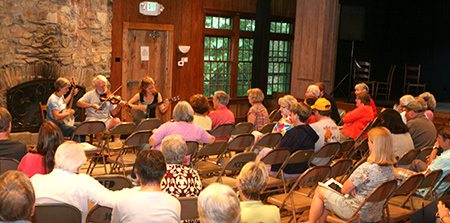 Martha, David and Annie Fain play Morningsong[/caption]
Cory Marie: I have been part of the Folk School community for only 2 years, so I’d like to hear about your story. Tell me about yourself.
Annie Fain: I was born in Charleston, West Virginia. Dad was there as part of a land study project for people who had sold their mineral rights to coal companies. The way my parents tell the story is that after my brother (Lindsey) was born, mom (Martha Owen) said "I'm going home to Murphy." Dad said, "Well, she had the kids and she had the check book," so he went with her!
Martha, David and Annie Fain play Morningsong[/caption]
Cory Marie: I have been part of the Folk School community for only 2 years, so I’d like to hear about your story. Tell me about yourself.
Annie Fain: I was born in Charleston, West Virginia. Dad was there as part of a land study project for people who had sold their mineral rights to coal companies. The way my parents tell the story is that after my brother (Lindsey) was born, mom (Martha Owen) said "I'm going home to Murphy." Dad said, "Well, she had the kids and she had the check book," so he went with her!
Brasstown Morris Dancers greeted the...
The Sunday Morning String Band,...


